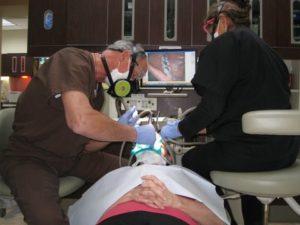
Methods to reduce mercury vapor exposure to both patient and operators during amalgam removal
- Eye Protection for our patients as well as dentist and staff.
- Pre-treatment rinse with oral detox, then suction out; repeat when mercury fillings have meen removed.
- Drape patient in dental chair with disposable drape or oversized bib.
- Provide an alternative source of air (oxygen) to patient via nasal mask, which ideally has a one-way valve and vacuum within nasal mask. Protect dental personnel with a non-rebreather gas mask.
- Isolate area being treated with a proper-fitted, non-latex dental dam. If dam use not possible, multiple high volumn and low volumn suctions can be used. Copious amounts of cool water must be used under both conditions with the spray focused on the junction of the handbiece burr and the filling being removed.
- When the last mercury filling has been removed, or before and between removals, an oral riinse with water and oral detox is appropriate, best care.
- A saliva ejector needs to be under the dental dam during mercury filling removal to pick up mercury vapors that will pass through the dental dam.
- Surround-type or 2 properly placed high volume suctions are best during merecury filling removal.
- Use a new carbide cutting burr to section Mercury fillings into as large “chunks” as possible. Keep up with the abundant rinsing.
- Purify the air with an ionizing filtering system and mercury vapor filtering systems.
- After mercury removal, dental personnel must remove gloves, wash hands thoroughly, and reglove.
- For high and low voulme suction at the chair, have a centralized Hg separator. Best units collect 99% of mercury before it goes to waste water. Dentistry is the only industry that is unregulated about pollution of Hg. We we must regulate ourselves voluntarily.
- Consider appropriate nutritional and physical support protocols under the care of a knowledgeable practitioner.
- Feel comfortable and confident that the particular restorative materials used have been evaluated for safest use. Use the most compatible and technically appropriate materials.
Protective Barriers (a review)
For virtually all operative procedures involving removing metals from the mouth, a rubber dam is used. Two high-volume suctions are in place on the “tooth-side” of the barrier and a low-volume suction is placed in the mouth, “air-way” side of the barrier. Mercury vapors that could pass through or around the rubber dam are thus vacuumed into our office filters and not inhaled by our patients.
After metal removal, we provide an oral detox lavage and suction to further evacuate potential vapors and particles.
Further barriers include eye and inhalation protection and frequently-changed drapes.